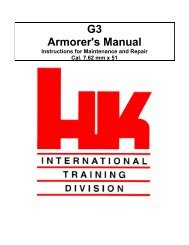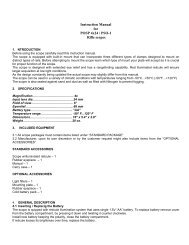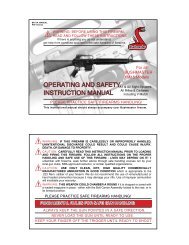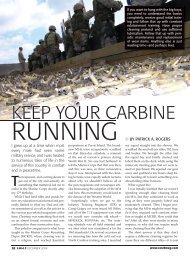FM 21-76 US ARMY SURVIVAL MANUAL - AR15.com
FM 21-76 US ARMY SURVIVAL MANUAL - AR15.com
FM 21-76 US ARMY SURVIVAL MANUAL - AR15.com
Create successful ePaper yourself
Turn your PDF publications into a flip-book with our unique Google optimized e-Paper software.
<strong>FM</strong> <strong>21</strong>-<strong>76</strong> <strong>US</strong> <strong>ARMY</strong> <strong>SURVIVAL</strong> <strong>MANUAL</strong> Reprinted as permitted by U.S. Department of the Army<br />
NEED FOR WATER<br />
The subject of man and water in the desert has generated considerable interest and confusion since the<br />
early days of World War II when the U. S. Army was preparing to fight in North Africa. At one time the U.<br />
S. Army thought it could condition men to do with less water by progressively reducing their water<br />
supplies during training. They called it water discipline. It caused hundreds of heat casualties.<br />
A key factor in desert survival is understanding the relationship between physical activity, air<br />
temperature, and water consumption. The body requires a certain amount of water for a certain level of<br />
activity at a certain temperature. For example, a person performing hard work in the sun at 43 degrees C<br />
requires 19 liters of water daily. Lack of the required amount of water causes a rapid decline in an<br />
individual's ability to make decisions and to perform tasks efficiently.<br />
Your body's normal temperature is 36.9 degrees C (98.6 degrees F). Your body gets rid of excess heat<br />
(cools off) by sweating. The warmer your body becomes--whether caused by work, exercise, or air<br />
temperature--the more you sweat. The more you sweat, the more moisture you lose. Sweating is the<br />
principal cause of water loss. If a person stops sweating during periods of high air temperature and<br />
heavy work or exercise, he will quickly develop heat stroke. This is an emergency that requires<br />
immediate medical attention.<br />
Figure 13-2 shows daily water requirements for various levels of work. Understanding how the air<br />
temperature and your physical activity affect your water requirements allows you to take measures to get<br />
the most from your water supply. These measures are--<br />
• Find shade! Get out of the sun!<br />
• Place something between you and the hot ground.<br />
• Limit your movements!<br />
• Conserve your sweat. Wear your complete uniform to include T-shirt. Roll the sleeves down,<br />
cover your head, and protect your neck with a scarf or similar item. These steps will protect your<br />
body from hot-blowing winds and the direct rays of the sun. Your clothing will absorb your sweat,<br />
keeping it against your skin so that you gain its full cooling effect. By staying in the shade quietly,<br />
fully clothed, not talking, keeping your mouth closed, and breathing through your nose, your water<br />
requirement for survival drops dramatically.<br />
• If water is scarce, do not eat. Food requires water for digestion; therefore, eating food will use<br />
water that you need for cooling.<br />
Page 135 of 233








